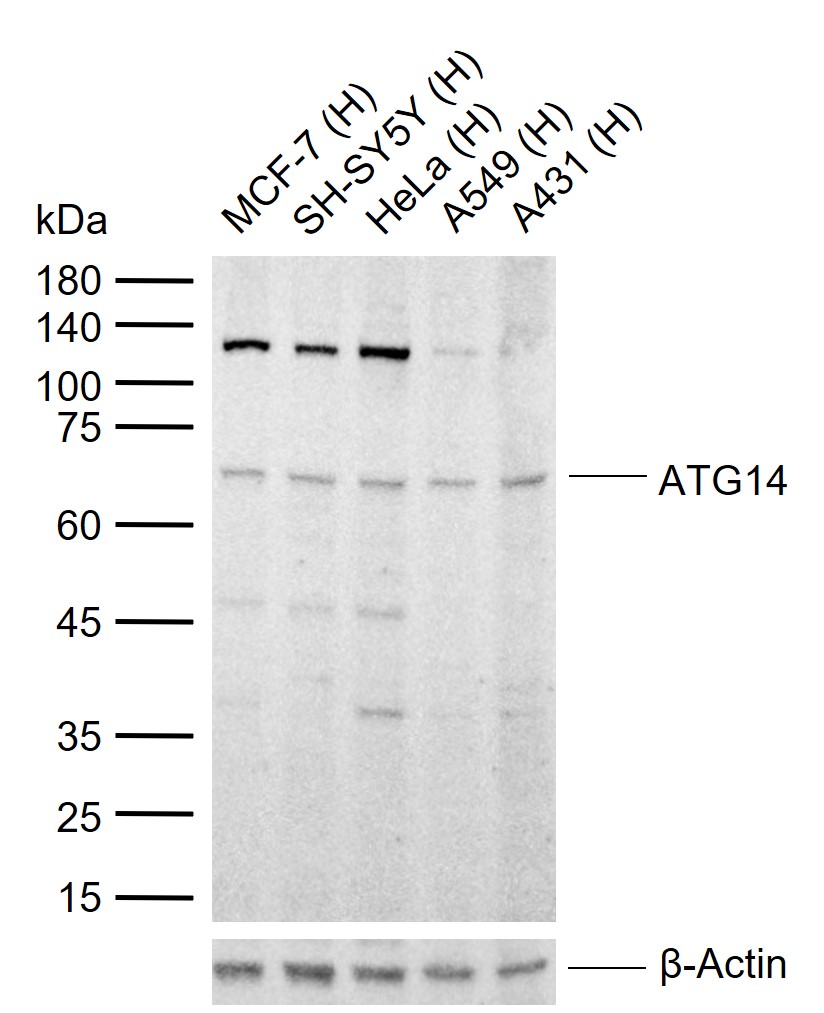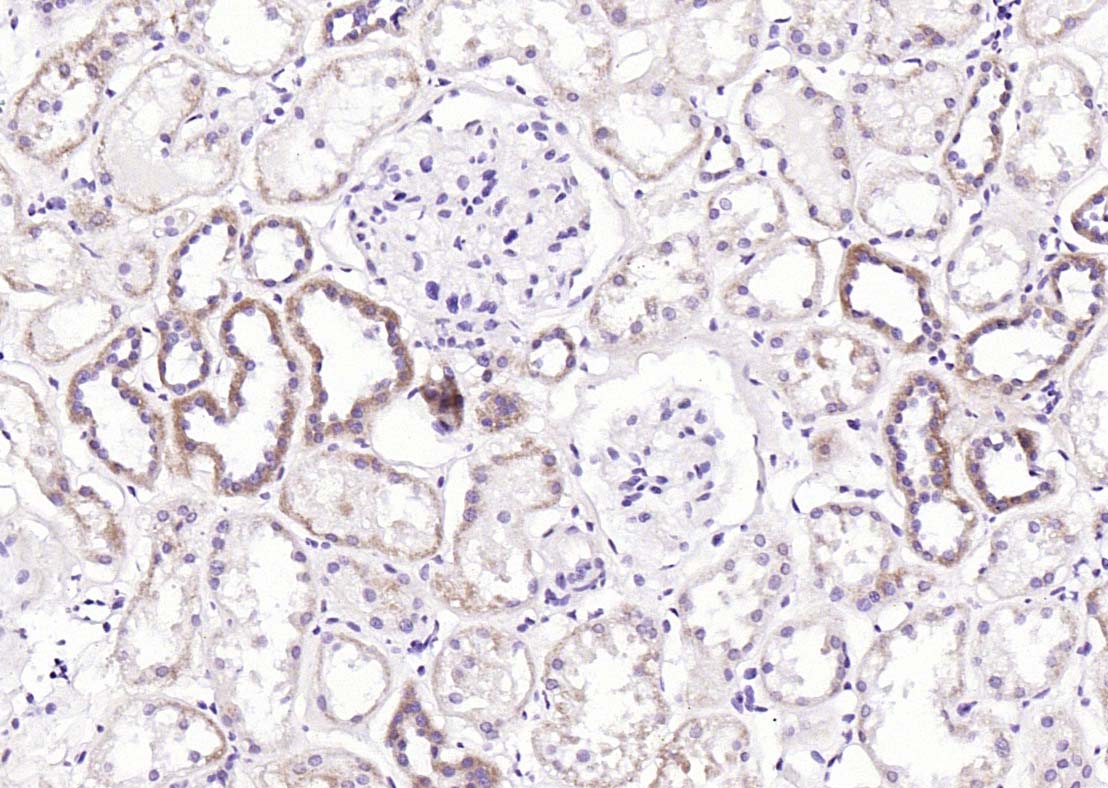ATG14 Rabbit pAb
ATG14 Rabbit pAb
- 产品详情
- 实验流程
- 背景知识
Application
| WB, IHC-P, IHC-F, IF |
|---|---|
| Primary Accession | Q6ZNE5 |
| Reactivity | Human |
| Predicted | Mouse, Rat, Dog, Pig |
| Host | Rabbit |
| Clonality | Polyclonal |
| Calculated MW | 55309 Da |
| Physical State | Liquid |
| Immunogen | KLH conjugated synthetic peptide derived from human ATG14 |
| Epitope Specificity | 41-140/492 |
| Isotype | IgG |
| Purity | affinity purified by Protein A |
| Buffer | 0.01M TBS (pH7.4) with 1% BSA, 0.02% Proclin300 and 50% Glycerol. |
| SUBCELLULAR LOCATION | Cytoplasm. Endoplasmic reticulum. Cytosolic under nutrient-rich conditions. Following autophagy stimuli, such as starvation or rapamycin induction, predominantly detected in cytoplasmic foci, identified as isolation membranes and autophagosomes. |
| SIMILARITY | Belongs to the Barkor family. |
| SUBUNIT | Component of the autophagy-specific PI3-kinase complex I composed of ATG14, BECN1, PIK3C3 and PIK3R4, but not UVRAG, nor KIAA0226/Rubicon. UVRAG and ATG14/Barkor form mutually exclusive complexes with BECN1 through direct competition. The complex containing ATG14 up-regulates autophagy, while the one containing Rubicon down-regulates autophagy (By similarity). Interacts with PIK3CB (By similarity). Interacts with BECN1P1/BECN2. |
| Important Note | This product as supplied is intended for research use only, not for use in human, therapeutic or diagnostic applications. |
| Background Descriptions | Required for both basal and inducible autophagy. Plays a role in autophagosome formation and MAP1LC3/LC3 conjugation to phosphatidylethanolamine. Promotes BECN1 translocation from the trans-Golgi network to autophagosomes. Enhances PIK3C3 activity in a BECN1-dependent manner. |
| Gene ID | 22863 |
|---|---|
| Other Names | Beclin 1-associated autophagy-related key regulator, Barkor, Autophagy-related protein 14-like protein, Atg14L, ATG14 {ECO:0000303|PubMed:18843052} |
| Dilution | WB=1:500-2000,IHC-P=1:100-500,IHC-F=1:100-500,IF=1:100-500 |
| Storage | Store at -20 °C for one year. Avoid repeated freeze/thaw cycles. When reconstituted in sterile pH 7.4 0.01M PBS or diluent of antibody the antibody is stable for at least two weeks at 2-4 °C. |
| Name | ATG14 {ECO:0000303|PubMed:18843052} |
|---|---|
| Function | Required for both basal and inducible autophagy. Determines the localization of the autophagy-specific PI3-kinase complex PI3KC3-C1 (PubMed:18843052, PubMed:19050071). Plays a role in autophagosome formation and MAP1LC3/LC3 conjugation to phosphatidylethanolamine (PubMed:19270696, PubMed:20713597). Promotes BECN1 translocation from the trans-Golgi network to autophagosomes (PubMed:20713597). Enhances PIK3C3 activity in a BECN1-dependent manner. Essential for the autophagy-dependent phosphorylation of BECN1 (PubMed:23878393). Stimulates the phosphorylation of BECN1, but suppresses the phosphorylation PIK3C3 by AMPK (PubMed:23878393). Binds to STX17-SNAP29 binary t-SNARE complex on autophagosomes and primes it for VAMP8 interaction to promote autophagosome-endolysosome fusion (PubMed:25686604, PubMed:37632749). Modulates the hepatic lipid metabolism (By similarity). |
| Cellular Location | Cytoplasm. Endoplasmic reticulum membrane; Peripheral membrane protein. Preautophagosomal structure membrane; Peripheral membrane protein. Cytoplasmic vesicle, autophagosome membrane; Peripheral membrane protein. Note=Cytosolic under nutrient-rich conditions (PubMed:19050071). Following autophagy stimuli, such as starvation or rapamycin induction, predominantly detected in cytoplasmic foci, identified as isolation membranes and autophagosomes (PubMed:19050071). Accumulates on highly curved PtdIns(3)P enriched autophagic membrane via its BATS domain to sense and maintain membrane curvature (By similarity). Also localizes to discrete punctae along the ciliary axoneme and to the base of the ciliary axoneme (By similarity). {ECO:0000250|UniProtKB:Q8CDJ3} |
Research Areas
For Research Use Only. Not For Use In Diagnostic Procedures.
Application Protocols
Provided below are standard protocols that you may find useful for product applications.
BACKGROUND
Required for both basal and inducible autophagy. Plays a role in autophagosome formation and MAP1LC3/LC3 conjugation to phosphatidylethanolamine. Promotes BECN1 translocation from the trans-Golgi network to autophagosomes. Enhances PIK3C3 activity in a BECN1-dependent manner.
终于等到您。ABCEPTA(百远生物)抗体产品。
点击下方“我要评价 ”按钮提交您的反馈信息,您的反馈和评价是我们最宝贵的财富之一,
我们将在1-3个工作日内处理您的反馈信息。
如有疑问,联系:0512-88856768 tech-china@abcepta.com.
¥ 1,500.00
Cat# AP58664























 癌症的基本特征包括细胞增殖、血管生成、迁移、凋亡逃避机制和细胞永生等。找到癌症发生过程中这些通路的关键标记物和对应的抗体用于检测至关重要。
癌症的基本特征包括细胞增殖、血管生成、迁移、凋亡逃避机制和细胞永生等。找到癌症发生过程中这些通路的关键标记物和对应的抗体用于检测至关重要。 为您推荐一个泛素化位点预测神器——泛素化分析工具,可以为您的蛋白的泛素化位点作出预测和评分。
为您推荐一个泛素化位点预测神器——泛素化分析工具,可以为您的蛋白的泛素化位点作出预测和评分。 细胞自噬受体图形绘图工具为你的蛋白的细胞受体结合位点作出预测和评分,识别结合到自噬通路中的蛋白是非常重要的,便于让我们理解自噬在正常生理、病理过程中的作用,如发育、细胞分化、神经退化性疾病、压力条件下、感染和癌症。
细胞自噬受体图形绘图工具为你的蛋白的细胞受体结合位点作出预测和评分,识别结合到自噬通路中的蛋白是非常重要的,便于让我们理解自噬在正常生理、病理过程中的作用,如发育、细胞分化、神经退化性疾病、压力条件下、感染和癌症。







